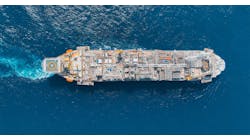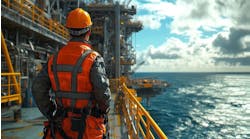Gastech 2024: ‘Green ammonia’ gains momentum as means of storing, transporting hydrogen
Carlos Guerrero * Bureau Veritas Marine & Offshore
As the world transitions towards cleaner energy solutions, green ammonia is gaining prominence as a crucial component of this shift. This is driven by international commitments to reduce greenhouse gas (GHG) emissions and the urgent need for sustainable energy alternatives. While the production of these fuels is accelerating, establishing an efficient transportation network to deliver them remains a critical challenge.
Ammonia, composed of hydrogen and nitrogen, has emerged as a promising solution for storing and transporting hydrogen, particularly in its green and blue forms. Compared to liquid hydrogen (LH2), ammonia presents a safer and more cost-effective option, overcoming significant safety and logistical hurdles associated with LH2 such as higher energy requirements for liquefaction and more stringent safety considerations due to its extremely low temperature and high flammability. This makes ammonia particularly valuable for power production and other sectors requiring a reliable hydrogen supply.
The maritime industry has long been a pioneer in safely transporting liquefied gases. Since the first commercial projects in 1964, liquefied natural gas (LNG) has been transported by ship with a proven safety record. Similarly, non-decarbonized ammonia has been transported in liquefied gas carriers, specifically mid-sized and handy LPG carriers and a few very large gas carriers (VLGC) in service are also ammonia capable. This existing infrastructure provides a solid foundation upon which the next generation of ammonia carriers can be built. These carriers will be essential in transporting blue and green ammonia to meet the rising demand for clean energy, potentially replacing a portion of the oil and gas trade.
Currently, ammonia-capable carriers constitute approximately one-third of the LPG carrier fleet. These vessels adhere to international safety regulations, such as the SOLAS Convention and IMO IGC Code, which set standards for safely transporting liquefied gases. While this regulatory framework ensures safe handling, it highlights the need for continued innovation to meet the evolving demands of the energy sector.
Anticipating the market’s future needs, notable advances are emerging in the design of ammonia carriers. Recent trends include increased cargo capacity, mirroring the evolution seen in LPG and ethane transport sectors. Modern VLGC carriers, with previous capacities around 80,000 cubic meters, are now being designed to hold over 90,000 cubic meters, while vessels transporting ethane are now reaching capacities of up to 100,000 cubic meters.
The first generation of very large ammonia carriers (VLAC) currently on order are comparable in size to modern VLGC or very large ethane carriers (VLEC), with designs aimed at optimizing transportation efficiency and cost. The next generation would include larger ships, with a cargo capacity similar than modern LNG carriers or even larger. These vessels are expected to enhance the scalability of ammonia transport, aligning with the industry’s goals of reducing GHG emissions and supporting the transition to greener fuels.
However, realizing this vision will depend on several factors. It is essential to evaluate emerging technologies and address any regulatory gaps. For instance, ammonia carriers require special materials for the cargo containment and handling systems and could be equipped with ammonia-fueled engines and associated gas supply systems. Additionally, guidelines for the safe use of ammonia as a fuel on board are being discussed, and the IMO has recently agreed to allow this new application through a future amendment to the IGC Code.
Bureau Veritas Marine & Offshore is working to support the maritime industry’s transition to greener fuels by developing classification rules, conducting risk analyses, and providing independent verification in safety and sustainability standards.





